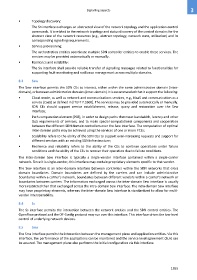Page 1365 - 5G Basics - Core Network Aspects
P. 1365
Signalling aspects 3
• Topology discovery:
The Sn interface exchanges an abstracted view of the network topology and the application-control
commands. It is related to the network topology and status discovery of the control domains for the
abstract view of the network resources (e.g., abstract topology, network state, utilization) and its
corresponding signalling requirements.
• Service provisioning:
The orchestration entities coordinate multiple SDN controller entities to enable these services. The
services may be provided automatically or manually.
• Resilience and reliability:
The Sn interface shall provide reliable transfer of signalling messages related to functionalities for
supporting fault monitoring and resilience management across multiple domains.
8.3 Sew
The Sew interface permits the SDN CEs to interact, either within the same administrative domain (intra-
domain), or between administrative domains (inter-domain). It is recommended that it support the following:
• Cloud mode, as well as network and communications services, e.g., NaaS and communication as a
service (CaaS) as defined in [ITU-T Y.3500]. The services may be provided automatically or manually.
SDN CEs should support service establishment, release, query and restoration over the Sew
interface;
• Path computation element (PCE), in order to design paths that meet bandwidth, latency and other
QoS requirements of services, and to make special computational components and cooperation
between the different SDN domain controllers over the Sew interface. The computation of optimal
inter-domain paths may be achieved using the services of one or more PCEs;
• Scalability refers to the ability of the SDN CEs to support ever-increasing requests and support for
different services with an existing SDN infrastructure;
• Resilience and reliability refers to the ability of the CEs to continue operations under failure
conditions and the ability of the CEs to recover their operation due to failure conditions.
The intra-domain Sew interface is typically a single-vendor interface contained within a single-carrier
network. Since it is single-vendor, this interface may contain proprietary elements specific to that vendor.
The Sew interface is an inter-domain interface between controllers within the SDN networks that cross
domain boundaries. Domain boundaries are defined by the carriers and can include administrative
boundaries within a carrier's network, boundaries between different vendors within a carrier's network or
boundaries between carriers. The information exchanged across the inter-domain Sew interface is usually
more restricted than that exchanged across the intra-domain Sew interface. The intra-domain Sew interface
may have proprietary elements, whereas the inter-domain Sew interface is standardized to allow for multi-
vendor interoperability.
8.4 Ss
The Ss interface permits the interaction between the network entities and the SDN control entities. The
OpenFlow protocol and the OF-Config protocol may run over this interface. This interface drives the low-level
control of underlying network devices.
8.5 Sma
The Sma interface permits the interaction between the management plane and application entities. Via this
interface, the performance of the applications can be monitored and the service level agreement (SLA) can
be assured. The management plane also performs the initial configuration via this interface.
1355

